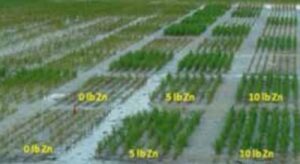OVERVIEW
- Zinc (Zn) deficiency is the most widespread micronutrient disorder in rice (Oryza sativa). Zn deficiency causes multiple symptoms that usually appear two to three weeks after planting. Plants lacking zinc remain stunted and in severe cases may die. Plants that survive may show substantial delay in maturity and reduction in yield (Figure A and B).
- Rice is very responsive to Zn application; therefore, it is critical to evaluate the effect of Zn application rates on rice yield.
- DAP + AS + ZnSO₄ is often used as a fertilizer blend applied to rice.
TRIAL DETAILS
Crop: Rice (Oryza sativa)
Year: 2011-2012
Locations: 6 trials across rice-growing regions of the U.S. (AR, LA, MS).
Experimental Design: Small-plot RCBD with 4 replications.
Data Source: Field studies conducted by University of Arkansas, Louisana State University and Mississippi State University.
Experimental Design: Small-plot RCBD with 4 replications.
Cropping Conditions: All trials conformed to local cropping practices.
P Rate: 80 lbs P₂O₅/ac
S Rate: 20 lbs S/ac balanced across treatments
Zn Rate: MicroEssentials® SZ® was applied at 2 lbs Zn/ac; DAP + AS + ZnSO₄ was applied at 5 different Zn rates (0, 2, 5, 8, 10 lbs Zn/ac).
Application Timing and Method: Preplant broadcast
RESULTS



SUMMARY
- Rice yields increased with higher rates of zinc.
- MicroEssentials® SZ® at 2 lbs Zn/ac demonstrated a 0.9 bu/ac higher yield than a DAP blend at 5 lbs Zn/ac. This zinc rate was 2.5 times greater than MicroEssentials® SZ®.
- Rice yield for MicroEssentials® SZ® at 2 lbs/ac Zn is statistically similar to the DAP + AS + ZnSO₄ blends applied at 5, 8 and 10 lbs Zn/ac.
- MicroEssentials® SZ® contains N, P, S and Zn fused into one nutritionally balanced granule providing uniform nutrient distribution, increased nutrient uptake and season-long sulfur availability.